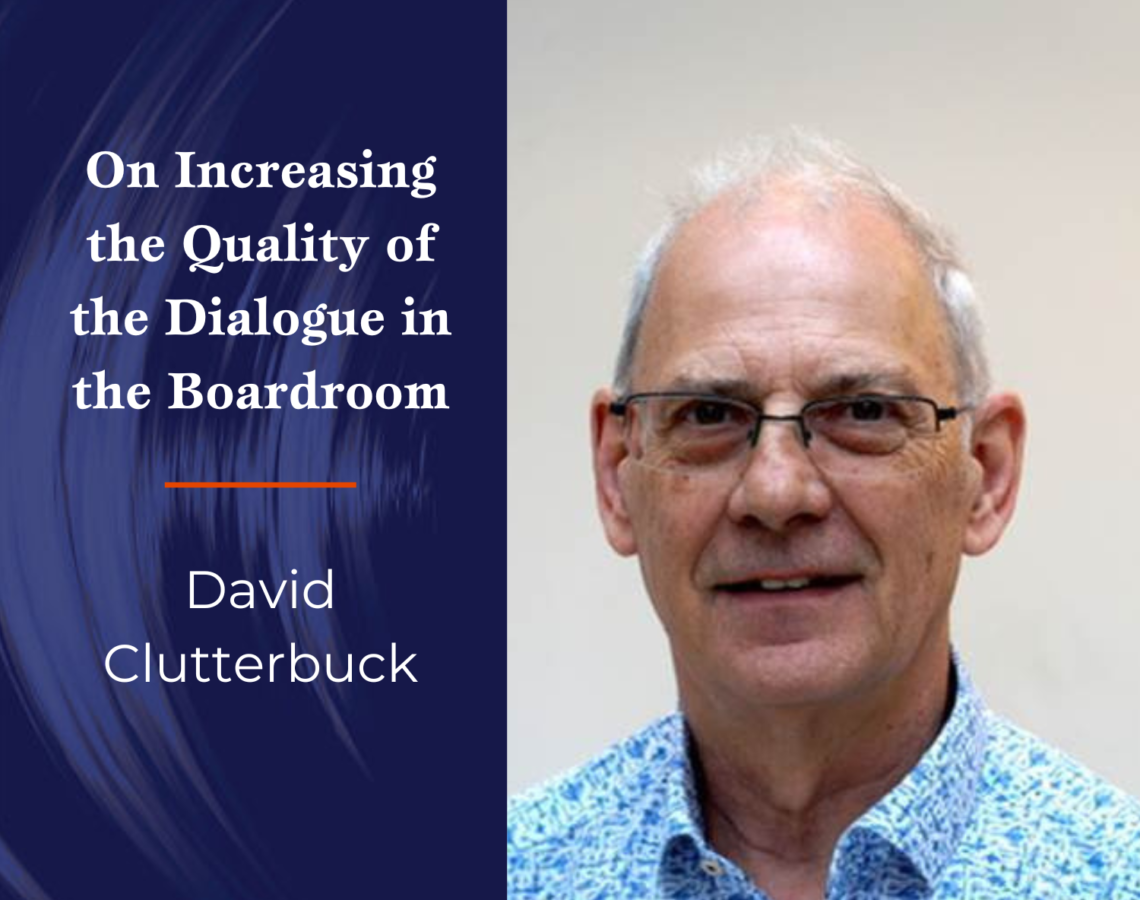On Increasing the Quality of the Dialogue in the Boardroom

It sounds all so easy – you create a board and expect that this group will be able to add tremendous value.
It sounds all so easy – you create a board and expect that this group will be able to add tremendous value. However, serving board members and observers as part of a board evaluation know that high-quality dialogue is not a given. The quality of dialogue is based on the willingness and skill of those in the room and the right structures and processes.
In this podcast, Dr Sabine Dembkowski, Founder and Managing Partner of Better Boards, discusses improving boardroom dialogue with David Clutterbuck, who has been involved with boards and governance for over 30 years. Visiting professor at three universities, he is the author/co-author of 75 books, including one of the first to explore the role of non-executive directors. He designed and facilitated the ‘Stepping Up to the Board’ programmes for the UK’s National School of Government and practical approaches for board assessment. He has worked with boards worldwide, helping them develop more productive dialogue. Practice lead for Coaching and Mentoring International, he is a leading authority globally on mentoring, coaching, and team coaching.
Some of the key takeaways of the conversation include:
“The board’s role is not to do all this stuff!”
David starts by explaining that there are many “big issues” at present, but often some boards desperately try to solve all these problems themselves. This is not the board’s role. Rather, they should ensure that all these issues are identified and processes put in place to manage them, and then monitor the quality of those processes. The board’s role is not to take action but to raise awareness. The executives should go and do the research, develop the strategies and plan, identify the tactics to implement those strategies, and finally report back to the board. The biggest mistake David sees is boards getting too involved in the detail, therefore doing too much or even getting in the way of executives doing their job.
“Boards which are not very effective are still thinking in linear ways”
David explains that in times of crisis, the line between executives and non-executives often becomes blurred. He believes that one of the key qualities of a board is to be able to rise above the complexity and help the executive steer through it. His research into post-COVID leadership with the Conference Board showed a capability deficit in senior executive roles compared to current needs in an ever-changing world. The need is not for linear thinking in terms of cause and effect, but one of the key competencies of a director is being a strong systemic thinker.
“Organisations suffer from what we call organisational arthritis”
David outlines how systemic thinking involves identifying the many layers of an issue. This is increasingly important at the board level, where you have the internal interacting systems and all the external ones, such as politics, economics, and the ecosystem. All these issues create a complex environment that is constantly evolving, and the board needs to be able to work within that complexity. Business needs to be able to operate within uncertainty, yet boards often push for more and more certainty from their executives. David believes this is because certainty is very often the most comfortable place for them. Yet, it creates what he refers to as “organisational arthritis” when the business can no longer move fast enough and change direction when necessary.
“Organisational climate is a big part of that organisational agility that prevents organisational arthritis”
David describes an increasing emphasis on values and ethics, and recommends that at least once a quarter, a board regularly considers whether the organisation is living up to its values. You can create an agile climate in an organisation in many ways, but having a strong sense of ethicality makes it more likely there will strong psychological safety in the organisation. He feels boards should concentrate on ensuring that executives create an environment where people feel safe enough to take appropriate risks, where innovation can happen fast, and people are not shut down for having or putting forward ideas challenging the status quo.
“We’re using the most valuable time of the meeting for rubbish”
David relates that in studies of good boardroom practice in the 1990s, the typical board agenda started with up to 45 minutes of apologies for absence, minutes of the last meeting, matters arising and much which could have been done by email beforehand. He points out that the first part of the meeting is when brains are most productive before people start getting tired. He recommends a simple tool – to give scores to all the items that could go on the agenda – 1 to 10 for urgency, and 1 to 20 for importance, and multiply the 2 scores for each potential agenda item. This gives a ranking order that should dictate the running order of items, with the highest scores first when energy is highest. This prevents important things from being left to last and then rushed.
“What are the criteria by which we’re judging this decision?”
David believes that how decisions are made is important. Voting is commonplace, but this tends to mean people go along with the majority and suppress contrary views. He explains that a much better way to decide is to determine the criteria by which the decision is judged. Taking each in turn, the discussion should be as to whether the decision meets the criteria. This is a much more detailed, focused analysis of the proposals on the table, and the likelihood of the proposal or decision being implementable effectively is increased dramatically.
“Really do get all of the opinions around the table about an issue”
David recommends that if executives present to the board, much time can be saved by having brief advance discussions with members to explain why this is being presented and the key points. Then the questions that get asked at the board meeting are meaningful, considered questions. He also advocates that when there is a really difficult or complex issue to discuss, ask everyone to reflect for five minutes and answer 3 questions. (1) What do you want to say about this issue? (2) What do you want other people to say about this issue? (3) What do you want to achieve from this discussion? Everybody reads out their responses, and there is no discussion until everybody has spoken. This decreases the discussion time because everybody knows each other’s perspective, and behaviour towards each other is much more positive. Also, once the decision is made, it is less likely to be challenged later.
The three top takeaways from our conversation are:
- Don’t get too involved in running the business. Recognise your role as a director, not an executive. If you’re an executive director, you’ve got to learn to break those two roles apart and let go of ‘doing,’ delegating as much as possible so you can focus on strategy.
- Think about why the board is there, which will help structure and prioritise discussion topics. Regularly, question whether the things you’re doing are creating value for the medium and long term or only the near future and profitability. How are you going to help the business to survive?
- Be the ethical conscience of the business, and do not forget the much bigger purpose. See your role in the totality.
Don’t forget to subscribe never to miss an episode of the Better Boards Podcast Series. Available on Apple, Spotify or Google.
To find out how you can participate in the Better Boards Podcast Series or more information on Better Boards’ solutions, please email us at info@better-boards.com.



